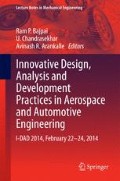Abstract
Lightweight design has become relevant to a lot of industry sectors, due to the wish to improve the CO2 balance of their products and to save resources. To reduce the weight of a vehicle there are different approaches to lightweight design, e.g. material substitution or lightweight construction types. These existing approaches are reaching their limits with conventional materials. For this reason lightweight materials like fibre-reinforced plastics are becoming more and more popular. However, these materials are very cost intensive. Therefore, these materials are generally used, in sports cars or in premium vehicles. In order to solve the conflict between vehicle costs and weight reduction, new lightweight approaches have to be developed for mass production. The opportunities of new materials can only be provided for a large group of customers through new approaches. One such approach is to combine fibre-reinforced plastics with the existing metallic materials. This is called multi-material or hybrid design. In this approach, the advantages of the two types of material are used for a specific application. Only then the lightweight potential can be used effective and at reasonable cost. For a vehicle, the multi-material design can be used in particular for designing the body in white. Here, almost every component can be considered by the new lightweight approach. Hybrid materials, for example, can increase the stiffness and reduce the weight of a rocker at the same time. For this the load cases of the rocker need to be analysed for which the load frequencies and amplitudes are needed. Also the life expectancy has to be determined in order to design a component with thin-walled sections as well as a minimal safety factor. Afterwards the material combination of the hybrid material is determined with respect to the load cases. Generally the fibre-reinforced plastics are placed in areas with tensile stress. Vice versa metallic materials are placed in areas with compressive stress. For designing the components ideally direct load should exist. In this case, the maximum potential for lightweight design can be used. The new lightweight approach will be developed within the Open Hybrid LabFactory together with research institutes and industrial companies. For this purpose, we gratefully thank the Federal Ministry of Education and Research for funding the research project.
Access this chapter
Tax calculation will be finalised at checkout
Purchases are for personal use only
References
Wallentowitz H, Freialdenhoven A, Olschewski I (2008) Strategien in der Automobilindustrie—Technologietrends und Marktentwicklungen, 3. Vieweg+Teubner Verlag, Wiesbaden. ISBN 9783834807250
Nehuis F, Sánchez Ruelas J, Stechert C, Vietor T (2013) Robust conception of vehicles considering region-specific requirements. In: Proceedings of the 19th international conference on engineering design (ICED’13), Seoul
Nationale Plattform Elektromobilität (NPE) (2011) Zweiter Bericht der Nationalen Plattform Elektromobilität. Gemeinsame Geschäftsstelle Elektromobilität der Bundesregierung (GGEMO), Berlin
Gies S, Lesemann M, Sahr C, Thoennes M (2008) Research needs and future trends in lightweight design. In: Proceedings of the international conference innovative developments für lightweight vehicle structures, Wolfsburg, Germany
Eckstein L, Schmitt F, Hartmann B (2010) Leichtbau bei Elektrofahrzeugen. ATZ Automobiltechnische Zeitung 112:S.788–S.795
Duflou J, de Moor J, Verpoest I, Dewulf W (2009) Environmental impact analysis of composite use in car manufacturing. CIRP Ann Manufact Technol 58:9–12
Ponn J, Lindemann U (2011) Konzeptentwicklung und Gestaltung technischer Produkte: Optimierte Produkte—systematisch von Anforderungen zu Konzepten. Springer Verlag, Berlin. ISBN 9783540685623
Nehuis F, Ibe M, Stechert C, Vietor T, Rausch A (2013) Clustering regional-specific requirements as a methodology to define the modules of a car concept. In: Chakrabarti A (ed) Proceedings of the 22nd CIRP design conference, Bangalore, India, Bd. Sustainable Product Development, pp 239–249. ISBN 9781447145066
Kroker J (2005) Schnittstellensystematik für modulare Fahrzeugkarosserien. PhD-Thesis, Technische Universität Braunschweig, Braunschweig
Franke H, Crull S, Koschorrek F, Krusche T (2006) Faszination Karosseriebau—Innovationen für zukünftige Karosseriekonzepte. Gesamtzentrum für Verkehr, Braunschweig, pp 13–31. ISBN 3937655034
Song Y, Youn J, Gutowski T (2009) Life cycle energy analysis of fiber-reinforced composites. Compos A 40:1257–1265
Prinz A, Nehuis F, Vietor T, Stechert C (2012) The effects of regional specific requirements on the development of vehicle concepts. In: Lienkamp M (ed) Proceedings of the conference on future automotive technology (Munich) Bd. Focus Electro Mobility. ISBN 9783658011406
Nehuis F, Stechert C, Vietor T (2011) Use of design methodology to accelerate the development and market introduction of new lightweight steel profiles. In: Culley BJ, McAloone TC, Howard TJ, Dong, ASJ, Hicks HSJ (eds) Proceedings of the 18th international conference on engineering design (ICED’11), Kopenhagen, Bd. 10. Design methods and tools, pp 321–330. ISBN 9781904670308
Acknowledgment
The research group will develop the new production technologies and design rules within the ForschungsCampus—‘New manufacturing technologies for economic and multifunctional lightweight’. In this group, they will elaborate innovative multi-material components and assemblies for the vehicle body. The results of this project will provide basic knowledge in production processes and product designs for lightweight vehicles.
The authors gratefully thank the German Federal Ministry of Education and Research (BMBF) for supporting the Project ForschungsCampus and also the companies involved in this project.
Author information
Authors and Affiliations
Corresponding author
Editor information
Editors and Affiliations
Rights and permissions
Copyright information
© 2014 Springer India
About this paper
Cite this paper
Nehuis, F., Kleemann, S., Egede, P., Vietor, T., Herrmann, C. (2014). Future Trends in the Development of Vehicle Bodies Regarding Lightweight and Cost. In: Bajpai, R., Chandrasekhar, U., Arankalle, A. (eds) Innovative Design, Analysis and Development Practices in Aerospace and Automotive Engineering. Lecture Notes in Mechanical Engineering. Springer, New Delhi. https://doi.org/10.1007/978-81-322-1871-5_3
Download citation
DOI: https://doi.org/10.1007/978-81-322-1871-5_3
Published:
Publisher Name: Springer, New Delhi
Print ISBN: 978-81-322-1870-8
Online ISBN: 978-81-322-1871-5
eBook Packages: EngineeringEngineering (R0)

